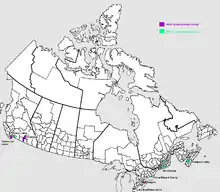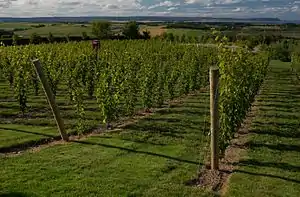Canadian wine
Canadian wine is wine produced in Canada. Ontario and British Columbia are the two largest wine-producing provinces in Canada, with two-thirds of the Canada's vineyard acreage situated in Ontario.[1] However, wine producing regions are also present in other provinces, including Alberta, Quebec, New Brunswick and Nova Scotia.
 |
| Part of a series on |
| Canadian cuisine |
|---|
|
In 2015, Canada produced 56.2 million litres of wine, with 62 per cent of that total originating from Ontario. The second largest wine-producing province, British Columbia, constitutes 33 per cent of Canada's wine production.[2] Between 2006 and 2011, 68 per cent of Canadian wine exports came from Ontario-based wineries; with 14 per cent of exports originating from British Columbia, 12 per cent from Quebec, and six per cent from Alberta.[1]
Icewine can be produced reliably in most Canadian wine-producing regions. As a result, Canada is the world's leading icewine producer, with more icewine produced in Canada than all other countries combined.[1] More than 90 per cent of Canadian icewines originates from Ontario,[3] although the product is also produced in British Columbia, Quebec, and Nova Scotia.[1] In addition to standard grape wines, and icewines, the country is also home to several fruit wineries and meaderies, found in provinces such as in Alberta, Saskatchewan and Manitoba, provinces whose local climate is not favourable for grape production.[4]
History
_(14592705550).jpg.webp)
Canadian wine has been produced for over 200 years. Early settlers tried to cultivate Vitis vinifera grapes from Europe with limited success. They found it necessary to focus on the native species of Vitis labrusca and Vitis riparia along with various hybrids. However, the market was limited for such wines because of their peculiar taste which was often called "foxy". However, this became less apparent when the juice was made into Port- and Sherry-styled wines. In 1866, the first commercial winery opened in Canada, situated on Pelee Island in Ontario.[1]
During the first half of the twentieth century, the temperance movement and later consumer demand for fortified and sweet wines hampered the development of a quality table wine industry. Consumer demand did not shift from sweet and fortified wines to drier and lower alcohol table wines until the 1960s. At the same time, there were significant improvements in wine-making technology, access to better grape varieties and disease-resistant clones, and systematic research into viticulture.
After the repeal of alcohol prohibition in Canada in 1927, provinces strictly limited the number of licences to produce wine. A nearly 50-year moratorium on issuing new winery licences was finally dropped in 1974. During the same decade, demonstration planting began to show that Vitis vinifera could be successfully grown in Canada. Other growers found that high quality wines could be produced if Vitis vinifera vines were grown with reduced yields, new trellising techniques, and appropriate canopy management.

In 1988, three important events occurred: free trade with the United States, the establishment of the Vintners Quality Alliance (VQA) standard, and a major grape vine replacement/upgrading program. The VQA acts as the regulatory and appellation system that intends to ensure "high quality" and "authenticity of origin" for Canadian wines from the provinces of British Columbia, and Ontario. Each of these events served in one way or another to improve the viability of the wine industry in Canada.
During the 1990s, Canadian vintners continued to demonstrate that fine grape varieties in cooler growing conditions could potentially possess complex flavours, delicate yet persistent aromas, tightly focused structure and longer ageing potential than their counterparts in warmer growing regions of the world.
Cellared in Canada
Cellared in Canada was a former indicator from 1994 to 2018 for wine products from Canadian wineries, whose grape must originated from outside of Canada.[5] Canadian wineries are able to import pre-fermented grape must from other countries, and use it to produce wine under their own products. The maximum quantity of foreign wine used in Cellared in Canada wine products depended on the province the wine originated from; with certain provinces requiring a minimum amount of local grapes be used in order for it to qualify as Cellared in Canada wine. In Ontario, 30 per cent of the grapes in Cellared in Canada wine had to originate from local wineries. Conversely British Columbia did not stipulate the use of local grapes in the production of its Cellared in Canada wine products.[6]
In late 2009, local and international criticism of the Cellared in Canada practice and the Liquor Control Board of Ontario (LCBO) emerged. Grape growers in Ontario began protesting the practice as a threat to their livelihood claiming that thousands of tons of Canadian grapes are left rotting on the vine because producers are using imported grapes to make wine labelled as "Canadian". Wine producers who do not use the "Cellared in Canada" designation criticized the practice as tarnishing the reputation of Canadian wines and misleading consumers. Producers and growers in Canada have petitioned the government for several changes in the practices such as making the origin of grapes more clear on the wine label and increasing the visibility of 100 per cent Canadian wines produced by members of the Vintners Quality Alliance (VQA) in province run liquor stores. As of August 2009, the province stores of the LCBO featured less than 2.5 per cent Canadian wine produced by VQA members with the vast majority of its wines produced under the "Cellared in Canada" designation with up to 70 per cent foreign grapes.[7]
In March 2018, the Canadian Food Inspection Agency announced the Cellared in Canada designation replaced by two new designations, dependent on the quantity of foreign wine mixed into the product. Products that are primarily made of foreign grapes are designated "International blend from imported and domestic wines"; whereas primarily domestic wines that contain foreign grapes are designated "International blend from domestic and imported wines".[8]
Market share
In 2015, the province of Quebec is the largest consumer of wine, with each resident consuming an average of 23 litres a year.[2] However, Canadian wines make up less than 50 per cent share of the Canadian wine market, making Canada one of the few wine-producing countries where domestically produced wines do not hold a dominant share. Wine in general has been increasing its market share against other alcoholic beverages (beer and spirits). Since the late 1990s wine has increased its market share from 21 per cent to 28 per cent and since 2007 wine sales have increased by 9.5 per cent to C$5 billion.[9]
While there are many small Canadian wineries, the domestic wine market has long been dominated by two companies, Vincor International and Andres Wines. In 2006, Vincor International, which had grown aggressively in previous years by acquiring wineries in California, Australia and New Zealand, was itself acquired by Constellation Brands, a U.S.-based company and one of the primary consolidators of the global wine business.
Global market
In 2017, Canadian wineries exported 2.1 million litres of wine (valued at C$39.6 million), and constitutes 0.1 per cent of global exports. The largest export markets for Canadian wine is China, the United States, South Korea, the Netherlands, and Japan.[10] Between 2006 and 2011, 68 per cent of Canadian wine exports came from Ontario-based wineries; with 14 per cent of exports originating from British Columbia, 12 per cent from Quebec, and six per cent from Alberta.[1]
Icewine is a major export product for Canadian wineries. Ontario is the largest exporter of icewine, exporting a value of C$21.3 million, followed by British Columbia, which exported a value of C$3.2 million.[10] However, the majority of icewines exported to France and Switzerland originate from Ontario and Quebec. Conversely, majority of Canadian sparkling wine imported in Switzerland originates from British Columbia.[1]
Production

In 2015, Canada produced 56.2 million litres of wine; 62 per cent of which originated from Ontario. The second largest wine-producing province, British Columbia, constitutes 33 per cent of Canada's wine production.[2] In particular, Canada is the largest producer of icewine, with Canada producing a greater volume of icewine than all other countries combined.[1] Icewine is made in every wine-producing region of Canada, although the majority of Canadian icewine is produced in Ontario, whose wineries constitute over 90 per cent of Canadian icewine production.[3]
In 2015, there are 548 wineries in Canada, spread over 12,150 hectares (30,000 acres). Ontario holds the largest acreage of vineyards in Canada, with 150 vineyards spread across 6,900 hectares (17,000 acres). There are three VQA designated viticultural areas in Ontario, the Niagara Peninsula (which includes ten different sub-appellations), Prince Edward County, and the north shore of Lake Erie.[3] Small but fast-growing wine industries can also be found in the Lambton and Huron County regions of Southwestern Ontario. Vitis vinifera is the most common grapevine grown in Ontario-based vineyards, with a focus on cultivating Chardonnay, Riesling, pinot noir, and Cabernet Franc.[3]
British Columbia holds 240 wineries, spread throughout 4,152 hectares (10,260 acres).[3] Wineries in British Columbia primarily grow vitis vinifera, with the top planted grapes being Chardonnay, Merlot, pinot gris, and pinot noir.[3] There are five VQA designated viticultural regions in British Columbia, Vancouver Island, the Gulf Islands, the Fraser Valley, Similkameen Valley, and the Okanagan Valley.[3]

There are 138 wineries in Quebec, which manage 808 hectares (2,000 acres) of vineyards in the province.[3] Vineyards in Quebec are primarily located to the north, and southeast of Montreal, as well as the surrounding area of Quebec City.[3] Nova Scotia holds 20 wineries, which manages 290 hectares (720 acres) of vineyards in the province.[3] Wine-producing areas in the province are primarily located along the shores of the Northumberland Strait, as well as Annapolis Valley. Most wineries in Nova Scotia are specialized towards the production of sparkling wine.[3]
The provinces Alberta, Manitoba, and Saskatchewan, also contain fruit wineries and meaderies.
See also
References
- "Market Analysis Report: A Global Export Market Overview for British Columbia's Wine Industry" (PDF). Government of British Columbia. 2012.
- Lupescu, Mihai (7 April 2017). "The Wine Market in the Province of Quebec". USDA Foreign Agricultural Service.
- "Canada On the World Map" (PDF). Wine Marketing Association of Ontario. 2015. Archived from the original (PDF) on 16 June 2016. Retrieved 8 March 2019.
- "Canada's Wine Regions". www.winesofcanada.com. Retrieved 27 May 2017.
- Logan, Nick (13 April 2016). "The Canadian wine you buy might not be as Canadian as you think". Global News. Corus Entertainment Inc. Retrieved 11 March 2019.
- Ejbich, Konrad. "Protest Mounts Over "Cellared in Canada" Wines". Wine Spectator. Wine Spectator Online. Retrieved 11 March 2019.
- K. Ejbich "Protest Mounts Over "Cellared in Canada" Wines" Wine Spectator, August 28, 2009
- Bregolisse, Doris Maria (13 May 2018). "Canadian winemakers celebrate misleading wine labeling change". Global News. Corus Entertainment Inc. Retrieved 11 March 2019.
- "Red, red wine: Health pros and cons". Retrieved 27 May 2017.
- "Industry Statistics". Canadian Vinters Association. 2017. Retrieved 8 March 2019.
Further reading
- Aspler, Tony (1999). Vintage Canada: The Complete Reference to Canadian Wines. McGraw-Hill Ryerson. ISBN 0-0708-6043-2.
- Phillips, Rod (2017). The wines of Canada. Infinite Ideas. ISBN 1-9109-0258-6.
- Schreiner, John (2005). The wines of Canada: Mitchell Beazley Classic Wine Library. Octopus Books. ISBN 1-8453-3628-3.
